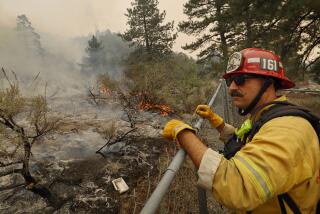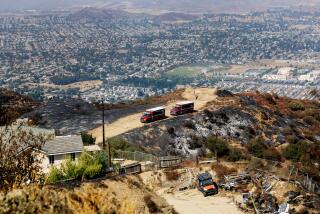Thousands Flee Wildfire in Drought-Stricken Shasta County : Disaster: A force of 1,800 battles the inferno that has claimed 63,000 acres. Five other major blazes continue.
- Share via
REDDING, Calif. — The worst blaze in a spate of wildfires in drought-stricken Northern California spread to 63,000 acres Saturday, threatening a onetime milling town in mountainous Shasta County and forcing about 7,500 people to evacuate their rural homes.
Although fire officials were allowing many residents to return to their homes by early evening, California 299 remained closed near the town of Burney as 1,800 firefighters continued to battle the blaze in round-the-clock shifts.
As night fell, the fire was described by one U. S. Forest Service spokeswoman as 30% contained, with 180 homes destroyed or damaged since Thursday. No major injuries were reported and no homes were believed to be in immediate danger in spite of fears that the fire would spread to new areas of timberland by crossing the Pitt River, fire officials said.
“It’s still a raging inferno,” Diane Robertson, a spokeswoman at the Shasta County fire command center, near Redding, said of the season’s largest blaze. Five other major wildfires around the state continued to burn Saturday as California suffered one of its worst fire season outbreaks in five years, officials said.
By midafternoon, as winds drove the Shasta blaze to within a mile of Burney, hundreds of firefighters lined up on the northern edge of the community to drive the blaze back, if necessary, and “to keep the town from going up,” one official said. With about 3,400 residents, many of them retirees, Burney is one of Shasta County’s biggest towns.
Firefighters successfully used backfires to stop the blaze just short of the town, which has been threatened by four major fires in the past 15 years, said Mike Witesman of the California Department of Forestry and Fire Protection.
More than half of the evacuated residents countywide were allowed to return home by nightfall, but 2,000 to 3,000 were forced to bed down in shelters rather than travel to homes in the small communities of Moose Camp, Montgomery Creek, Hillcrest and Round Mountain, said U.S. Forestry spokeswoman Beth Paulson.
The Shasta County blaze, of unknown origin, began Thursday afternoon and quickly ran through the town of Round Mountain, population 800, destroying or damaging up to 60 structures and forcing officials to close California 299 east of Interstate 5.
Round Mountain resident Bill Dunlap, 44, said the only thing left unscorched at his home was an old auto chassis in his front yard--and his swimming pool. “The house is ashes,” he said.
Teresa Royat, a U.S. Forestry Service firefighter who helped save a man’s house and barn near the community of Bootleg, near California 299, said: “I haven’t seen fire like that for years. I wasn’t sure if we were going to walk out or if they were going to come in and find us.”
Dense smoke also hampered firefighters. Capt. Robert Schulz of the Tehama County Fire Department, who was driving through part of the fire area 20 miles east of Redding, said: “I had my headlights on high beam and I couldn’t see 30 feet in front of me.”
The main concerns of firefighters working to stop the blaze was the 18-mile length of the fire line--more than tired crews could handle--and the steady march of flames to within a few hundred yards of the Pitt River, which empties into Shasta Lake. If the fire jumps the river, Witesman said, it could climb steep terrain in the Shasta-Trinity National Forest, destroying untold acres of valuable timberland.
Fire officials had no estimate for when they might contain or control the fire.
Because of the danger to life and property, fire officials said the Shasta fire was their top priority, but the five other major wildfires caused concern throughout the day.
In Southern California, flames scorched about 7,000 acres in the Inyo National Forest in the Mammoth Lakes area, and about 1,000 people in the region were evacuated. But, as of late Saturday afternoon, fire dispatcher Pete Engel said the “town (of Mammoth Lakes) is no longer in any imminent danger.”
Firefighters also continued to battle a 700-acre blaze in Cachuma in the Santa Barbara area; a 6,400-acre fire in the lightly settled town of Hayfork in Trinity County, and a 750-acre fire near Fiddletown in El Dorado County. Meanwhile, the Old Gulch fire in Calaveras County was declared 100% contained Saturday morning--after causing more than $7 million in damage, including the loss of 42 homes.
Although damage estimates from the ongoing fires were scant, fire officials predicted that statewide losses will reach tens of millions of dollars. The state is at its highest phase for firefighting readiness. State firefighters are being aided by federal forestry crews and local departments.
“We’re very busy,” said Lisa Boyd, a spokeswoman with the Forestry Department. “We’ve been looking at a maximum drain on our crews.”
Yet even as more relief arrived in Northern California in the form of hundreds of National Guard firefighters and four more federal air support craft, three more wildfires fires broke out Saturday afternoon--outside the town of Smartville, near Auburn; outside Mariposa, southwest of Yosemite, and south of Oroville, in Butte County, officials said.
Although these blazes threatened some property, they were considered relatively small, officials said. “They’ve just started, so they’re not even on the priority list at this time,” a state information officer said.
Although the recent outbreak is one of the worst in parched California since the Northern California wildfires of September, 1987, some fear an even worse fire season may lie ahead.
Donn Zea, vice president of industry affairs for the California Forest Assn., a trade group made up of forest product companies, said this year’s fires have broken out earlier than in other seasons, “and if we get some dry storms, we’ll be in real trouble come September or October.”
His group blames the problem in part on the increase in dead and dying trees, which fuel forest fires. The trade group also is pointing to the fires in renewing its calls for the federal government to adopt a more aggressive program for clearing forests of these trees.
“It’s obvious that the increased number of dead and dying trees is going to be a catastrophe unless we do something,” Zea said. “It’s a recipe for disaster.”
Paddock reported from Redding and Lichtblau from Los Angeles. Times staff writer David Ferrell in Los Angeles also contributed to this report.
More to Read
Sign up for Essential California
The most important California stories and recommendations in your inbox every morning.
You may occasionally receive promotional content from the Los Angeles Times.













